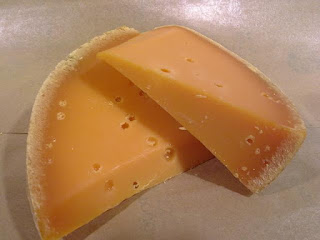New Years is quickly approaching and I wanted to provide a quick and fun recipe so you can have one more dish in your entertaining arsenal: mini toasts with Pesto Genovese and melted Nicasio Reserve.
My wonderful friend Raschel pointed out that I don't always include the specifics on the cheeses that I feature (like milk type and rennet) and I plan on including that information in all future posts. Here is the breakdown for Nicasio Reserve:
Cheese: Nicasio Reserve
Producer: Nicasio Valley Cheese Company
Location: Nicasio, CA, United States
Milk: Pasteurized Cow
Rennet: Traditional (animal)Now that the nitty gritty is out of the way, I have to tell you that this is absolutely one of my favorite cheeses. We got this cheese back in a couple of days ago and I was over the moon! The Nicasio Reserve is a Swiss-Italian Alpine style cheese that is aged for a minimum of 3 months. It is 100% organic and one of the most versatile cheeses that I have ever come across. When you cut into the wheel, you see a very clean, white paste riddled with eyes (holes). The smell is slighty floral with a hint of grass. But the taste, oh the taste, is what wins you over. It starts off very mild and milky then opens up into a complex yet balanced earthiness with a little hint of the aforementioned grass. I use this cheese for both cheese plates and for cooking. The melting quality of this cheese is phenomenal and I have yet to find a recipe where substituting this cheese is detrimental.
The recipe that I cooked up today was super tasty. Most of my team members tried it and they approved. Here's what you'll need to make 24 tasty little toasts:
1 package of 365 Mini Toasts or equivalent
1/3 lb Pesto Genovese or whatever pesto is your favorite
1/2 lb Nicasio Reserve - grate/shred at home
Those are all the ingredients you need. Preheat the oven to 350%. Take a baking sheet and line with parchment paper (makes the mess easier to deal with later). Lay out all of the mini toasts.
Take a butter knife and spread a little dollop of pesto onto the toast.
Generously cover with the shredded/grated Nicasio Reserve.
Then pop it in the oven for ten minutes and you'll get....
... This!
Use these little bites whenever you're in need of a quick appetizer or snack. Very simple and super delicious. I hope you all have a fantastic New Years! I can't wait to write more in 2013! Until then, eat, drink and be happy!

















































